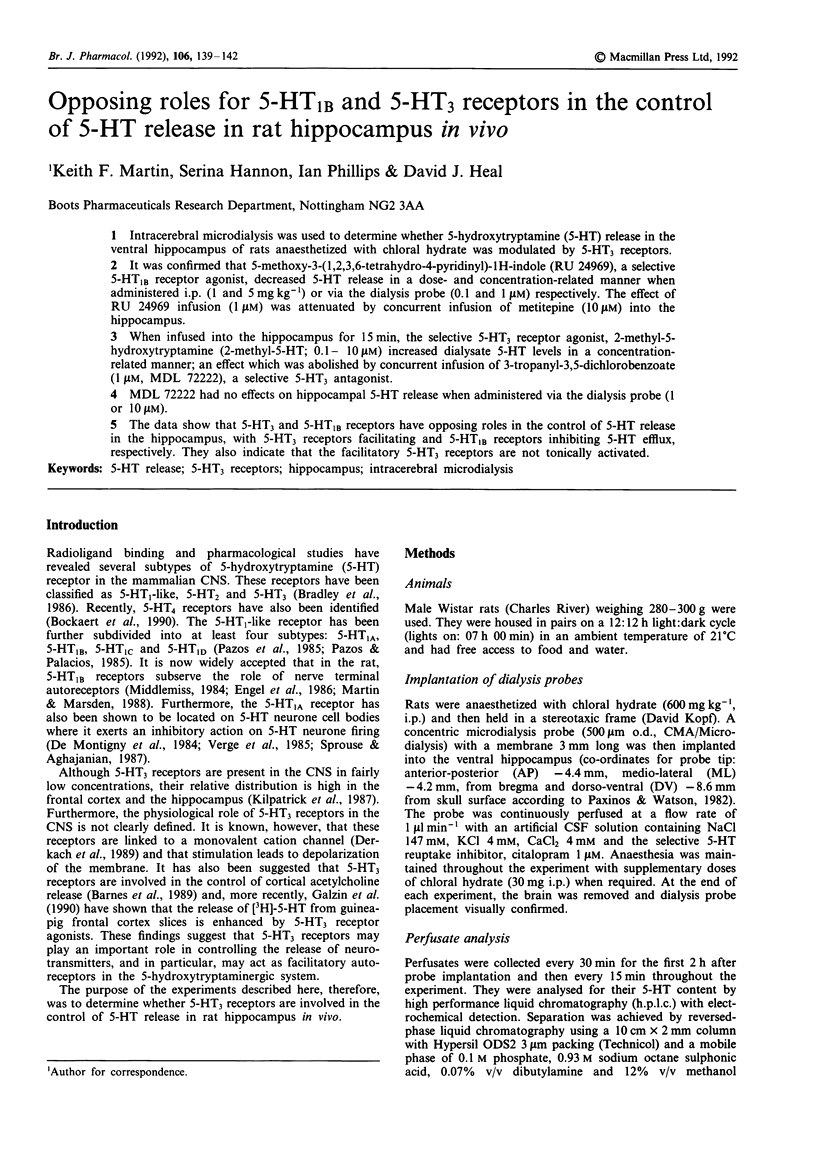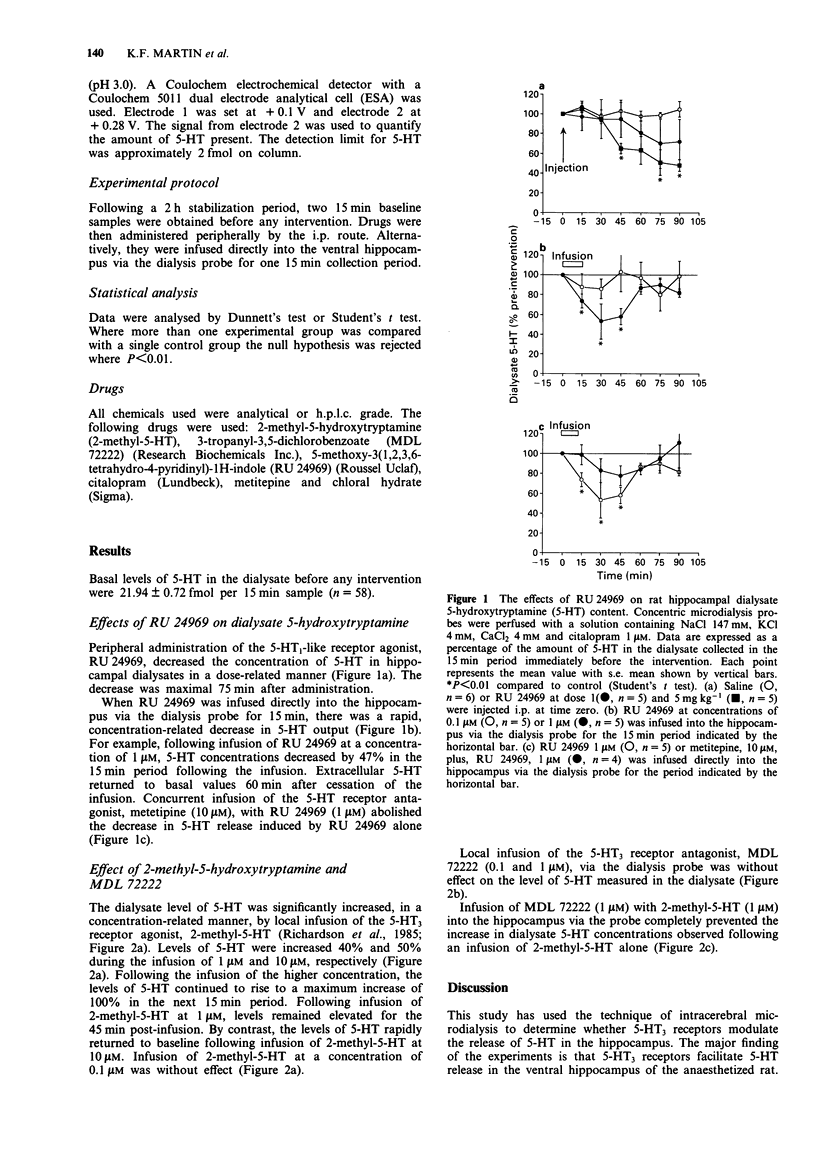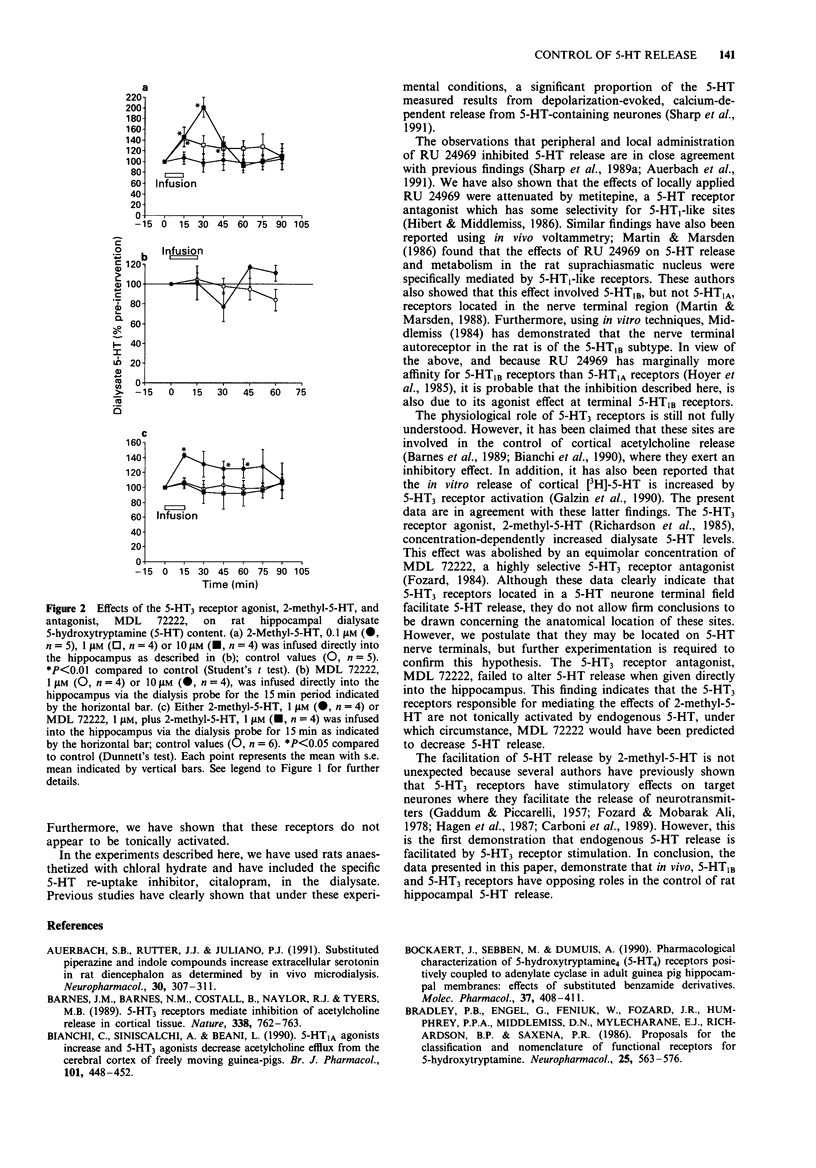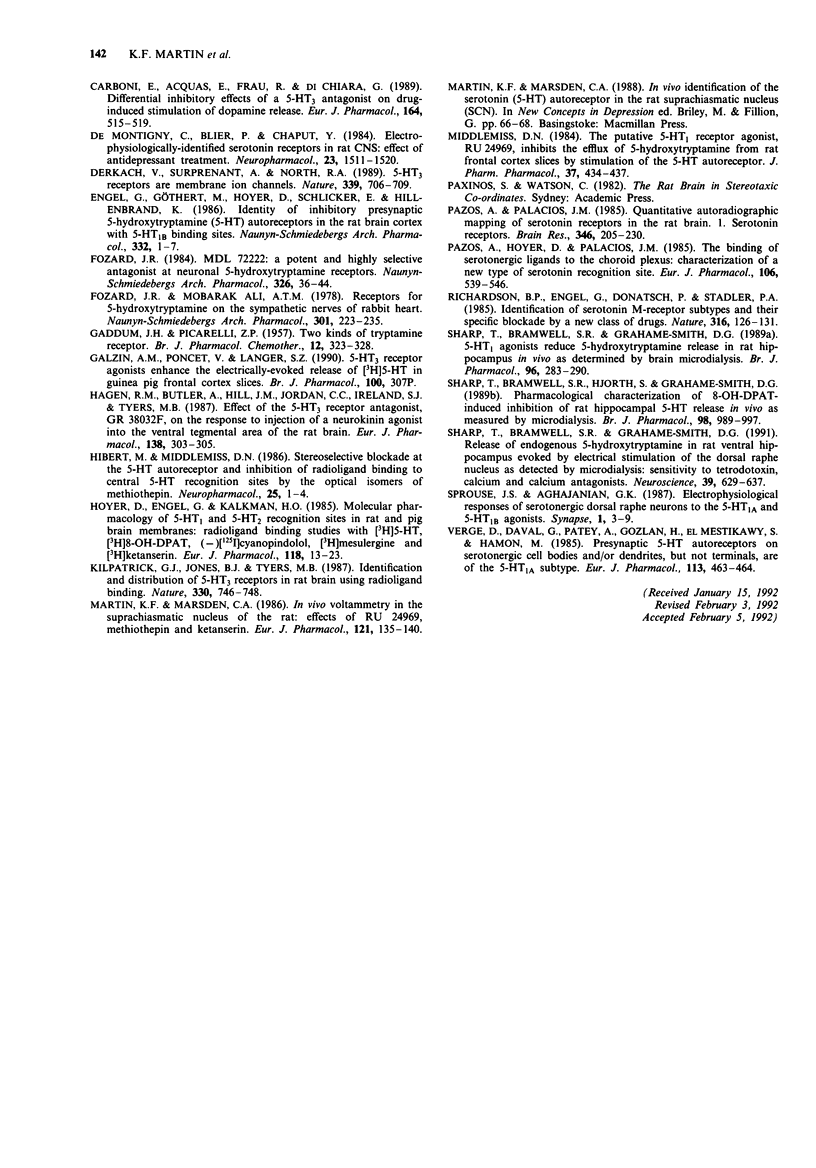Abstract
1. Intracerebral microdialysis was used to determine whether 5-hydroxytryptamine (5-HT) release in the ventral hippocampus of rats anaesthetized with chloral hydrate was modulated by 5-HT3 receptors. 2. It was confirmed that 5-methoxy-3-(1,2,3,6-tetrahydro-4-pyridinyl)-1H-indole (RU 24969), a selective 5-HT1B receptor agonist, decreased 5-HT release in a dose- and concentration-related manner when administered i.p. (1 and 5 mg kg-1) or via the dialysis probe (0.1 and 1 microM) respectively. The effect of RU 24969 infusion (1 microM) was attenuated by concurrent infusion of metitepine (10 microM) into the hippocampus. 3. When infused into the hippocampus for 15 min, the selective 5-HT3 receptor agonist, 2-methyl-5-hydroxytryptamine (2-methyl-5-HT; 0.1- 10 microM) increased dialysate 5-HT levels in a concentration-related manner; an effect which was abolished by concurrent infusion of 3-tropanyl-3,5-dichlorobenzoate (1 microM, MDL 72222), a selective 5-HT3 antagonist. 4. MDL 72222 had no effects on hippocampal 5-HT release when administered via the dialysis probe (1 or 10 microM). 5. The data show that 5-HT3 and 5-HT1B receptors have opposing roles in the control of 5-HT release in the hippocampus, with 5-HT3 receptors facilitating and 5-HT1B receptors inhibiting 5-HT efflux, respectively. They also indicate that the facilitatory 5-HT3 receptors are not tonically activated.
Full text
PDF



Selected References
These references are in PubMed. This may not be the complete list of references from this article.
- Auerbach S. B., Rutter J. J., Juliano P. J. Substituted piperazine and indole compounds increase extracellular serotonin in rat diencephalon as determined by in vivo microdialysis. Neuropharmacology. 1991 Apr;30(4):307–311. doi: 10.1016/0028-3908(91)90054-f. [DOI] [PubMed] [Google Scholar]
- Barnes J. M., Barnes N. M., Costall B., Naylor R. J., Tyers M. B. 5-HT3 receptors mediate inhibition of acetylcholine release in cortical tissue. Nature. 1989 Apr 27;338(6218):762–763. doi: 10.1038/338762a0. [DOI] [PubMed] [Google Scholar]
- Bianchi C., Siniscalchi A., Beani L. 5-HT1A agonists increase and 5-HT3 agonists decrease acetylcholine efflux from the cerebral cortex of freely-moving guinea-pigs. Br J Pharmacol. 1990 Oct;101(2):448–452. doi: 10.1111/j.1476-5381.1990.tb12728.x. [DOI] [PMC free article] [PubMed] [Google Scholar]
- Bockaert J., Sebben M., Dumuis A. Pharmacological characterization of 5-hydroxytryptamine4(5-HT4) receptors positively coupled to adenylate cyclase in adult guinea pig hippocampal membranes: effect of substituted benzamide derivatives. Mol Pharmacol. 1990 Mar;37(3):408–411. [PubMed] [Google Scholar]
- Bradley P. B., Engel G., Feniuk W., Fozard J. R., Humphrey P. P., Middlemiss D. N., Mylecharane E. J., Richardson B. P., Saxena P. R. Proposals for the classification and nomenclature of functional receptors for 5-hydroxytryptamine. Neuropharmacology. 1986 Jun;25(6):563–576. doi: 10.1016/0028-3908(86)90207-8. [DOI] [PubMed] [Google Scholar]
- Carboni E., Acquas E., Frau R., Di Chiara G. Differential inhibitory effects of a 5-HT3 antagonist on drug-induced stimulation of dopamine release. Eur J Pharmacol. 1989 May 30;164(3):515–519. doi: 10.1016/0014-2999(89)90259-8. [DOI] [PubMed] [Google Scholar]
- Derkach V., Surprenant A., North R. A. 5-HT3 receptors are membrane ion channels. Nature. 1989 Jun 29;339(6227):706–709. doi: 10.1038/339706a0. [DOI] [PubMed] [Google Scholar]
- Engel G., Göthert M., Hoyer D., Schlicker E., Hillenbrand K. Identity of inhibitory presynaptic 5-hydroxytryptamine (5-HT) autoreceptors in the rat brain cortex with 5-HT1B binding sites. Naunyn Schmiedebergs Arch Pharmacol. 1986 Jan;332(1):1–7. doi: 10.1007/BF00633189. [DOI] [PubMed] [Google Scholar]
- Fozard J. R., Ali A. T. Receptors for 5-hydroxytryptamine on the sympathetic nerves of the rabbit heart. Naunyn Schmiedebergs Arch Pharmacol. 1978 Jan-Feb;301(3):223–235. doi: 10.1007/BF00507041. [DOI] [PubMed] [Google Scholar]
- Fozard J. R. MDL 72222: a potent and highly selective antagonist at neuronal 5-hydroxytryptamine receptors. Naunyn Schmiedebergs Arch Pharmacol. 1984 May;326(1):36–44. doi: 10.1007/BF00518776. [DOI] [PubMed] [Google Scholar]
- GADDUM J. H., PICARELLI Z. P. Two kinds of tryptamine receptor. Br J Pharmacol Chemother. 1957 Sep;12(3):323–328. doi: 10.1111/j.1476-5381.1957.tb00142.x. [DOI] [PMC free article] [PubMed] [Google Scholar]
- Hagan R. M., Butler A., Hill J. M., Jordan C. C., Ireland S. J., Tyers M. B. Effect of the 5-HT3 receptor antagonist, GR38032F, on responses to injection of a neurokinin agonist into the ventral tegmental area of the rat brain. Eur J Pharmacol. 1987 Jun 19;138(2):303–305. doi: 10.1016/0014-2999(87)90450-x. [DOI] [PubMed] [Google Scholar]
- Hibert M., Middlemiss D. N. Stereoselective blockade at the 5-HT autoreceptor and inhibition of radioligand binding to central 5-HT recognition sites by the optical isomers of methiothepin. Neuropharmacology. 1986 Jan;25(1):1–4. doi: 10.1016/0028-3908(86)90050-x. [DOI] [PubMed] [Google Scholar]
- Hoyer D., Engel G., Kalkman H. O. Molecular pharmacology of 5-HT1 and 5-HT2 recognition sites in rat and pig brain membranes: radioligand binding studies with [3H]5-HT, [3H]8-OH-DPAT, (-)[125I]iodocyanopindolol, [3H]mesulergine and [3H]ketanserin. Eur J Pharmacol. 1985 Nov 26;118(1-2):13–23. doi: 10.1016/0014-2999(85)90658-2. [DOI] [PubMed] [Google Scholar]
- Kilpatrick G. J., Jones B. J., Tyers M. B. Identification and distribution of 5-HT3 receptors in rat brain using radioligand binding. Nature. 1987 Dec 24;330(6150):746–748. doi: 10.1038/330746a0. [DOI] [PubMed] [Google Scholar]
- Martin K. F., Marsden C. A. In vivo voltammetry in the suprachiasmatic nucleus of the rat: effects of RU24969, methiothepin and ketanserin. Eur J Pharmacol. 1986 Feb 11;121(1):135–139. doi: 10.1016/0014-2999(86)90403-6. [DOI] [PubMed] [Google Scholar]
- Middlemiss D. N. The putative 5-HT1 receptor agonist, RU 24969, inhibits the efflux of 5-hydroxytryptamine from rat frontal cortex slices by stimulation of the 5-HT autoreceptor. J Pharm Pharmacol. 1985 Jun;37(6):434–437. doi: 10.1111/j.2042-7158.1985.tb03032.x. [DOI] [PubMed] [Google Scholar]
- Pazos A., Hoyer D., Palacios J. M. The binding of serotonergic ligands to the porcine choroid plexus: characterization of a new type of serotonin recognition site. Eur J Pharmacol. 1984 Nov 27;106(3):539–546. doi: 10.1016/0014-2999(84)90057-8. [DOI] [PubMed] [Google Scholar]
- Pazos A., Palacios J. M. Quantitative autoradiographic mapping of serotonin receptors in the rat brain. I. Serotonin-1 receptors. Brain Res. 1985 Nov 4;346(2):205–230. doi: 10.1016/0006-8993(85)90856-x. [DOI] [PubMed] [Google Scholar]
- Richardson B. P., Engel G., Donatsch P., Stadler P. A. Identification of serotonin M-receptor subtypes and their specific blockade by a new class of drugs. Nature. 1985 Jul 11;316(6024):126–131. doi: 10.1038/316126a0. [DOI] [PubMed] [Google Scholar]
- Sharp T., Bramwell S. R., Grahame-Smith D. G. 5-HT1 agonists reduce 5-hydroxytryptamine release in rat hippocampus in vivo as determined by brain microdialysis. Br J Pharmacol. 1989 Feb;96(2):283–290. doi: 10.1111/j.1476-5381.1989.tb11815.x. [DOI] [PMC free article] [PubMed] [Google Scholar]
- Sharp T., Bramwell S. R., Grahame-Smith D. G. Release of endogenous 5-hydroxytryptamine in rat ventral hippocampus evoked by electrical stimulation of the dorsal raphe nucleus as detected by microdialysis: sensitivity to tetrodotoxin, calcium and calcium antagonists. Neuroscience. 1990;39(3):629–637. doi: 10.1016/0306-4522(90)90247-2. [DOI] [PubMed] [Google Scholar]
- Sharp T., Bramwell S. R., Hjorth S., Grahame-Smith D. G. Pharmacological characterization of 8-OH-DPAT-induced inhibition of rat hippocampal 5-HT release in vivo as measured by microdialysis. Br J Pharmacol. 1989 Nov;98(3):989–997. doi: 10.1111/j.1476-5381.1989.tb14630.x. [DOI] [PMC free article] [PubMed] [Google Scholar]
- Sprouse J. S., Aghajanian G. K. Electrophysiological responses of serotoninergic dorsal raphe neurons to 5-HT1A and 5-HT1B agonists. Synapse. 1987;1(1):3–9. doi: 10.1002/syn.890010103. [DOI] [PubMed] [Google Scholar]
- Verge D., Daval G., Patey A., Gozlan H., el Mestikawy S., Hamon M. Presynaptic 5-HT autoreceptors on serotonergic cell bodies and/or dendrites but not terminals are of the 5-HT1A subtype. Eur J Pharmacol. 1985 Jul 31;113(3):463–464. doi: 10.1016/0014-2999(85)90099-8. [DOI] [PubMed] [Google Scholar]
- de Montigny C., Blier P., Chaput Y. Electrophysiologically-identified serotonin receptors in the rat CNS. Effect of antidepressant treatment. Neuropharmacology. 1984 Dec;23(12B):1511–1520. doi: 10.1016/0028-3908(84)90095-9. [DOI] [PubMed] [Google Scholar]


